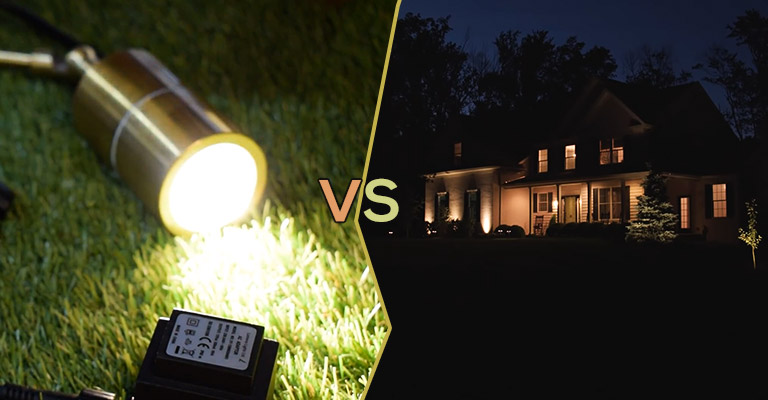What Is The Difference Between A Semi Flush And A Flush Mount Fixture?
Lighting fixtures with semi-flush or flush mounts are probably the ones you often see in your home. Various styles and finishes are available, they do not require much space, and they are versatile.
Your first lighting layer should be overhead lights, followed by task and ambient lighting. Since ceiling lights come in so many styles, you can find one that suits your mood and interior design theme.
If you’re looking for ceiling lights, flush mount light fixtures can provide a nice, easy light while still looking nice. Semi-flush mounts and flush mounts are the two most common ceiling lights. See what they’re all about and also their differences.
What Is A Semi-Flush Mount Light Fixture?
Lights that are semi-flush mounted have a more decorative appearance than those that are flush mounted. There is a gap of about 4-8 inches between the base of the light fixtures and the ceiling instead of being completely mounted to it.
Semi-flush mount lighting is more attractive and is commonly used in kitchens, bedrooms, dining rooms, and restaurants. However, there is a difference between these ceiling light fixtures and pendant lighting, which extends further from the ceiling.
A semi-flush mount light fixture is usually more luxurious than a flush mount light. Additionally, they tend to illuminate a room better since they have a gap between the light and ceiling, and they create a better ambiance thanks to LED ceiling lights.
Due to the gap, the light has a more uplifting effect since it reflects off the ceiling instead of being more direct, like flush mount lights.
What Is A Flush Mount Light Fixture?
Ceiling-mounted flush mount lights usually have a dome shape and are mounted on the ceiling. There are many different styles of these lights, and they are often used in residential areas. School, office, closet, bathroom, hallway, bedroom, and kitchen ceiling lights can all benefit from flush mount ceiling lights.

Lighting fixtures that blend seamlessly into the décor can be used on flush ceilings. The designs of flush mount light fixtures range from classic and minimal to modern and elaborate. Since flush mount ceiling lights are less likely to let bugs and dust into the fixture, they are also easier to clean.
The Difference Between Flush Mount and Semi-Flush Mount
There are two types of flush-mount and semi-flush-mount ceiling lights, but their final appearances are very different:
Semi-flush mounts hang down several inches from the ceiling, leaving airspace between the ceiling and the fixture. Flush mounts sit directly on the ceiling, while semi-flush mounts hang down several inches from the ceiling.

Light bulbs in semi-flush mounts are lowered roughly 4 to 8 inches from the ceiling by a stem at the center. As a result, there are often more decorative elements in semi-flush mount lights than in flush mount lights.
In flush-mount lights, there is no visible stem lowering the sockets below ceiling level and holding the fixtures in place. The bulbs appear to be mounted directly on the ceiling as a result. Flush-mount fixtures blend into any existing decor because of their simple, minimalist designs.
Characteristics of Semi Flush And Flush Mount Fixture
Lighting fixtures referred to as flush mounts have very little to no space between them and the ceiling. In addition to circular flush mount fixtures, you can also find square, oval, and rectangular models.
This type of light will seamlessly complement your decor. Many designers offer flush mount fixtures in ornate, decorative styles, but you can still find some pretty minimal styles.
Light fixtures with semi-flush mounts are almost flush mounts, but they have a small gap between them and the ceiling. Rather than being as low as pendant lighting, this fixture is supported by a stem or similar part.

Usually, the gap is no more than a few inches high. Although you can find more minimal styles, this type of lighting is usually more ornate and decorative than flush mount lighting.
Generally, semi-flush mount fixtures and flush mount fixtures look similar. Their main difference is the small space between them. On average, both types of fixtures measure 13 inches wide, although you can also find designs that measure 12 and 24 inches wide.
For both types, you have access to a variety of styles. Many of them are either minimalist or classic or ornate or modern. Finishes include nickel, gold, brass, brushed or reflective finishes, and shades from fabrics to glass, including the crystal.
If you are shopping for ceiling lights, keep an eye out for well-known brands. In addition to Elegant Designs, Westinghouse, Kichler, and Progress Lighting, other brands are known for high-quality semi-flush mount and flush mount lighting.
Flush And Semi-Flush Mount Lighting Uses
You can use semi-flush mount or flush mount lighting in most rooms of your home, but they are best for rooms where you’d prefer general overhead lighting rather than directional, spot, or mood lighting.
Almost every room of your home could benefit from the addition of flush-mount or semi-flush-mount lighting, especially in the rooms you want to provide a general, ambient light source.
Particularly useful in a hallway, kitchen, family room, bathroom, closet, and bedroom. Within the constraints of a small area, an attempt is made to replicate daylight’s appearance and feel.
Flush and semi-flush mount lighting is perfect for bathrooms, hallways, kitchens, and closets. In addition, since flush mounts maximize the limited ceiling space, they are an excellent choice for areas with low ceilings.
It is best to use semi-flush mounts in a living room or den where you want an elegant and functional embellishment.
Flush vs. Semi-Flush Lighting | Which One To Choose?
Flushes and semi-flushes can be used in most rooms, but one type might be better suited for certain rooms:
- It may be better to use semi-flush lights in rooms where ambient illumination is needed since light will reflect off the ceiling while also shining downward from the fixture.
- Lighting that is decorative semi-flush enhances the ambiance of a room where you entertain guests.
- It is cost-effective to install flush-mount lighting in hidden areas like closets.
- When you have low ceilings, flush-mount lighting gives you the most overhead clearance.
That being said, can you replace a flush mount with a semi-flush mount? With semi-flush adapters, some flush mount lights can be installed in two ways. If you aren’t sure what type to purchase, these fixtures are a smart choice.
What Are The Benefits Of Flush-Mounted And Semi-Flush-Mounted Fixtures?
Light from both ceiling light fixtures is efficiently distributed throughout a room, which is a characteristic they both share. It is great to have both ceiling lights because they have great ceiling clearance, and they blend in well with the surrounding area.
With an average width of 13 inches, these flush ceiling lights are sometimes strategically placed in rooms to conceal ceiling marks. LED flush mount ceiling lights are one of the most beneficial types of ceiling lights.

LED ceiling lights are not only more practical and energy efficient, but they also create a pleasant, bright, and welcoming atmosphere.
Furthermore, once installed, LED ceiling light fixtures are practically maintenance-free and highly functional. The light from LED flush ceiling lights is minimal and non-intrusive, despite emitting a bright light.
Flush Mount Lights vs. Semi-Flush Mount | Pros & Cons
Knowing the pros and cons of the semi-flush mount and flush mount light fixtures is important when comparing them. They are not all that different from one another, but each has some characteristics you might wish to avoid.
Pros and Cons of Flush Mount Lighting
Lights that are flush mount are great if you wish to reduce the amount of time you spend dusting the fixtures. Considering how close it is to the ceiling, there won’t be a lot of dust accumulating on it. In addition, you can install it on ceilings up to eight feet high.

There are some cons to flush mount lights; however: you will have to disassemble the light fixture each time you need to change a bulb. In addition, flush mount lighting doesn’t stand out very much, so it’s not the right solution for adding style to your decor.
Pros and Cons of Semi-Flush Mount Lighting
Low ceilings (9 to 10 feet high) are also a great fit for semi-flush mount lighting fixtures. In general, semi-flush fixtures have a more elegant look than flush fixtures because they tend to feature more ornaments.
For smaller dining rooms with low ceilings, it is a good choice. You won’t have to remove the whole fixture to change a burned-out light bulb in a semi-flush light.
Cleaning semi-flush mount fixtures, however, is more frequent than cleaning flush mount fixtures. Getting dirty is easier when dust accumulates faster. A ceiling less than nine feet high is not a good choice either.
Which One To Use?
If you hold firm to your decision that ceiling lights are the best option for you, you can cut the number of options in half by knowing if you require a Semi-Flush or Flush Mount.
Semi-flush fixtures hang down a few inches from the ceiling, leaving space between them and the ceiling. It may be difficult to install certain fixtures based on the height of your ceiling:
- If your ceilings are low (less than 20cm), you would prefer a flush mount light fixture (if your ceiling is low, you might opt for a semi-flush or chandelier).
- In cases where ceiling height is 21cm to 25cm), a semi-flush mount light is appropriate. Typically, they hang a foot or less from the ceiling.
- A chandelier or pendant should be considered for over 25cm ceilings.
- The best place for a flush mount light fixture is a hallway, closet, bedroom, or bathroom.
- Light fixtures with semi-flush attachments add an elegant touch to kitchen nooks and dining rooms with low ceilings.
The Bottom Line
In the realm of ceiling lighting, understanding the subtle distinctions between a semi-flush ceiling light and a flush fixture can greatly influence the aesthetics and functionality of a space. The semi-flush fixture, with its slight gap between the ceiling and the light, allows for a broader diffusion of light, making it an excellent choice for rooms that require both decorative flair and ample illumination. On the other hand, a flush fixture sits directly against the ceiling, ideal for rooms with a low ceiling where a pendant light or other lighting fixtures might feel overwhelming.
Choosing the correct ceiling light fixture requires a balance of aesthetic preference and practical considerations. While both flush mount and semi-flush fixtures offer their unique advantages, it’s essential to consider the room’s height, design, and desired ambient illumination. By weighing these factors, homeowners can enhance their spaces with the right blend of style and function.
In conclusion, when selecting the best lighting fixture for your home, remember to factor in the nuances between semi-flush and flush mount fixtures. By acknowledging the distinctions and benefits of each, you can guarantee a cohesive, harmonious, and well-lit ambiance that complements other elements of your décor.






